What is a Slab?
Slabs are constructed to provide flat surfaces, usually horizontal in building floors, roofs, bridges, and other types of structures. The slab may be supported by walls or by reinforced concrete beams usually cast monolithically with the slab or by structural steel beams or by columns, or by the ground. Slabs are classified into 16 types.
Different Types of concrete slabs in construction:-
There are 16 different types of Slabs in Construction. Some of them are outdated and many of them are frequently used everywhere. In this article, ill give a detailed explanation of each slab and where to use a particular slab. Below are the types of concrete slabs.
Since this is a lengthy article, we have created a table of contents below for easy navigation.
Contents
- Different Types of concrete slabs in construction:-
- Flat Slab:-
- Flat Slabs are used at:
- Advantages of Flat Slab:
- Disadvantages of Flat slab:
- There are four different types of concrete Flat Slabs:-
- Conventional Slab:-
- 1. One Way Slab:
- 2. Two Way Slab:
- Hollow core ribbed Slab or Hollow core slab:-
- Hollow core slab installation:-
- Hollow core slab Advantages :
- Hollowcore slab Disadvantages:
- Hardy Slab:-
- The process of hardy blocks execution is as follows:
- Where to use Hardy Slab?
- Advantages of Hardy Slab:
- Disadvantages of Hardy Slab:
- Hardy slabs are further classified into two types:
- Waffle Slab:-
- Where to use Waffle Slab & Waffle slab details:
- Types of Waffle slabs:
- Advantages of Waffle slabs:
- Disadvantages of Waffle slabs:
- Dome Slab:-
- Pitch roof slab:
- Advantages of Pitched roof type of Slab:
- Disadvantages of Pitched roof type of Slab:
- Slab with Arches:
- Post tension slab:
- Advantages of Post tension slab:
- Disadvantages of Post tension slab:
- Pre Tension Slab :
- Cable suspension slab:
- Low roof slab:
- Projected slab:
- Grads Slab/ Slab on grade:
- There are two types of Grade slabs:
- Sunken Slab :
- Miscellaneous Slabs:
- Room Chajja or Loft :
- Kitchen Slab :
- Lintels:
- Sun Shade slab:
Flat Slab:-
The flat slab is a reinforced concrete slab supported directly by concrete columns or caps. Flat slab doesn’t have beams so it is also called a beam-less slab. They are supported on columns itself. Loads are directly transferred to columns. In this type of construction, a plain ceiling is obtained thus giving an attractive appearance from an architectural point of view. The plain ceiling diffuses the light better and is considered less vulnerable in the case of fire than the traditional beam slab construction. The flat slab is easier to construct and requires less formwork. This is one of the types of concrete slabs.
The thickness of the Flat slab is minimum 8″ or 0.2m.
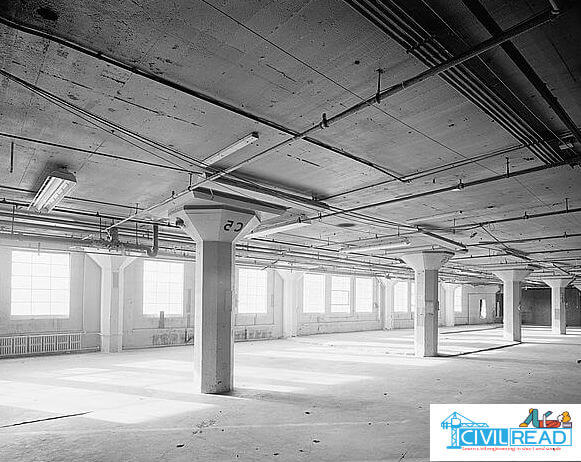
Flat Slabs are used at:
- To provide plain ceiling surface giving better diffusion of light
- Easy constructability with the economy in the formwork
- Larger headroom or shorter storey height & pleasing appearance.
- This kind of slabs are provided in the parking
- Flat slabs are generally used in parking decks, commercial buildings, hotels or places where beam projections are not desired.
Advantages of Flat Slab:
- It minimizes floor-to-floor heights when there is no requirement for a deep false ceiling. Building height can be reduced
- Auto sprinkler is easier.
- Less construction time.
- It increases the shear strength of the slab.
- Reduce the moment in the slab by reducing the clear or effective span.
Disadvantages of Flat slab:
- In a flat plate system, it is not possible to have a large span.
- Not suitable for supporting brittle (masonry) partitions.
- Higher slab thickness.
There are four different types of concrete Flat Slabs:-
- Slab without drop and column without column head(capital).
- Slab with drop and column without column head.
- Slab without drop and column with column head.
- Slab with drop and column with column head.
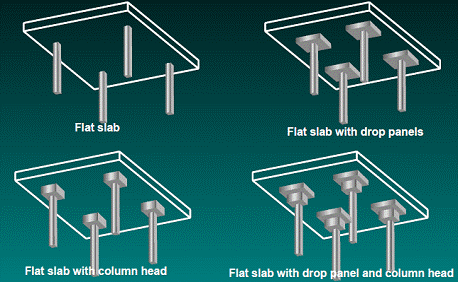
Conventional Slab:-
The slab which is supported on Beams and columns is called a conventional slab. In this kind, the thickness of the slab is small whereas the depth of the beam is large and load is transferred to beams and then to columns. It requires more formwork when compared with the flat slab. In the conventional type of slab there is no need for providing column caps. The thickness of conventional slab is 4″ or 10cm. 5″ to 6″ inches is recommended if the concrete will receive occasional heavy loads, such as motor homes or garbage trucks.
Conventional concrete slabs are square in shape and have a length of 4m. Reinforcement is provided in conventional slab and the bars which are set in horizontal are called Main Reinforcement Bars and bars which are set in vertical are called Distribution bars.
Based on the length and breadth of Conventional Slab is classified into two types:
1. One Way Slab:
One way slab is supported by beams on the two opposite sides to carry the load along one direction. The ratio of longer span (l) to shorter span (b) is equal or greater than 2, considered as One-way slab. In this type, the slab will bend in one direction i.e in the direction along its shorter span. However minimum reinforcement known as distribution steel is provided along the longer span above the main reinforcement to distribute the load uniformly and to resist temperature and shrinkage stresses.

In general, the length of the slab is 4m. But in one way slab, one side length is 4m and another side length is more than 4m. So it satisfies the above equation. Main reinforcement is provided in shorter span and distribution reinforcement is provided in the longer span. Main bars are cranked to resist the formation of stresses.
Example: Generally all the Cantilever slabs are one Way slab. Chajjas and verandahs are a practical example of one way slab.
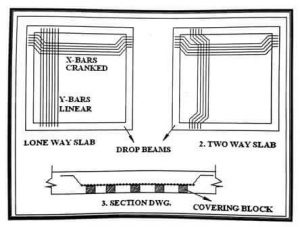
2. Two Way Slab:
Two way slab is supported by beams on all the four sides and the loads are carried by the supports along with both directions, it is known as two way slab. In two way slab, the ratio of longer span (l) to shorter span (b) is less than 2. The slabs are likely to bend along both the directions to the four supporting edges and hence distribution reinforcement is provided in both the directions.

In this kind of slab, the length and breadth of the slab are more than 4m. To resist the formation of stresses distribution bars are provided at both the ends in two way slab.
These types of slabs are used in constructing floors of multi-storeyed building.
Hollow core ribbed Slab or Hollow core slab:-
Hollowcore ribbed slabs derive their name from the voids or cores which run through the units. The cores can function as service ducts and significantly reduce the self-weight of the slabs, maximizing structural efficiency. The cores also have a benefit in sustainability terms in reducing the volume of concrete used. Units are generally available in standard 1200 mm widths and in depths from 110mm to 400 mm. There is total freedom in the length of units. These type of slabs are Pre cast and it is used where the construction has to be done fast.
The hollow core ribbed slabs have between four and six longitudinal cores running through them, the primary purpose of the cores being to decrease the weight, and material within the floor, yet maintain maximal strength. To further increase the strength, the slabs are reinforced with 12mm diameter steel strand, running longitudinally. This is one of the types of concrete slabs.
Hollow core slab installation:-
By using tower cranes Hollow slabs are inserted between the beams. The gaps between the slab is filled with screed.
Screed is a concrete material generally we use 20mm aggregate in concrete whereas in screed we use baby chips(small broken stones) as aggregates.
Hollow core ribbed slabs have excellent span capabilities, achieving a capacity of 2.5 kN/m2 over a 16m span. The long-span capability is ideal for offices, retail or car park developments. Units are installed with or without a structural screed, depending on requirements. Slabs arrive on-site with a smooth Pre-finished soffit. In car parks and other open structures, Pre-finished soffits offer a maintenance free solution.

Hollow core slab Advantages :
- Hollow core ribbed slab not only reduces building costs it also reduces the overall weight of the structure.
- Excellent fire resistance and sound insulation are other attributes of hollow core slab due to its thickness.
- It eliminates the need to drill in slabs for electrical and plumbing units.
- Easy to install and requires less labour.
- Fast in construction
- No additional formwork or any special construction machinery is required for reinforcing the hollow block masonry.
Hollowcore slab Disadvantages:
- If not properly handled, the hollow core ribbed slab units may be damaged during transport.
- It becomes difficult to produce satisfactory connections between the precast members.
- It is necessary to arrange for special equipment for lifting and moving of the precast units.
- Not economic for small spans.
- Difficult to repair and strengthen
Hardy Slab:-
Hardy slabs are generally seen in Dubai and China. Hardy slab is constructed by hardy Bricks. Hardy bricks are hollow bricks and made up of concrete Hollow blocks. These blocks are used to fill portions of the slab. Hardy slabs save the amount of concrete and hence the own weight of the slab is reduced. This kind of slab has a more thickness 0.27m when compared with the conventional one. The method of installing Hardy slab is different from normal and it is clearly explained below:
The dimensions of Hardy brick is 40cm x 20cm x 20cm
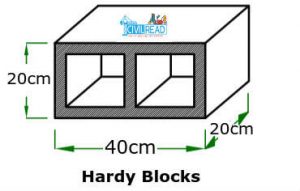
The process of hardy blocks execution is as follows:
Step 1: Formwork is arranged and then shutters are fixed on the formwork.
Step 2: Hardy blocks are placed on the shutter with one brick gap on the entire shutter.
Step 3: The gaps between the bricks are called a rib. Reinforcement is provided in a form of the beam within the gap.
Step 4: After placing the rib, the plain steel mesh is placed on the entire slab area resting on ribs.
Step 5: Now pouring of concrete is done on a slab.
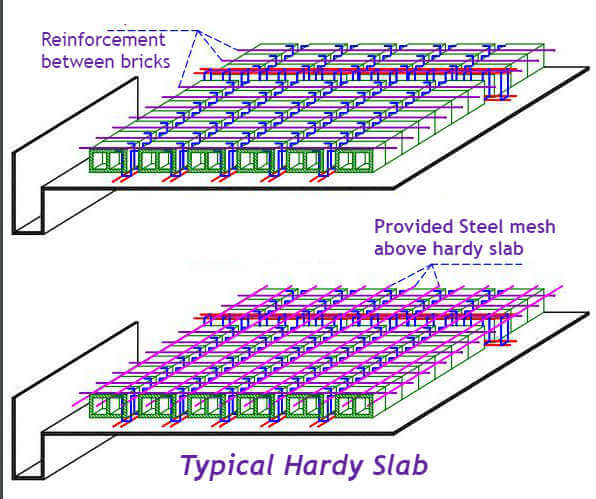
Where to use Hardy Slab?
Hardy slab is used where temperatures are very high. To resist the temperature from the top of the slab thickness is increased. The heat coming from walls are resisted by using special bricks which has thermacol in it. Thermacol is the best insulator of sunlight.
Advantages of Hardy Slab:
- Reducing slab weight by reducing the amount of concrete below the neutral axis.
- Ease of construction, especially when all beams are hidden beams.
- Economic for spans > 5m with moderate live load: hospitals, office and residential buildings.
- Improved insulation for sound and heat.
Disadvantages of Hardy Slab:
- If not properly handled, the hollow core ribbed brick units may be damaged during transport.
- Not economic for small spans.
- Difficult to repair and strengthen
Hardy slabs are further classified into two types:
- One way Hardy Slab
- Two way Hardy slab
Waffle Slab:-
Waffle slab is a reinforced concrete roof or floor containing square grids with deep sides and it is also called as grid slabs. This kind of slab is majorly used at the entrance of hotels, Malls, Restaurants for good pictorial view and to install artificial lighting. This a type of slab where we find a hollow hole in the slab when the formwork is removed. Firstly PVC trays (pods) are placed on shuttering then reinforcement is provided between the pods and steel mesh is provided at top of the pods and then concrete is filled. After concrete sets, the formwork is removed and PVC pods are not removed. This forms a hollow hole in it in which hole is closed at one end. The concrete waffle slab is often used for industrial and commercial buildings while wood and metal waffle slabs are used in many other construction sites. This is one of the types of concrete slabs.
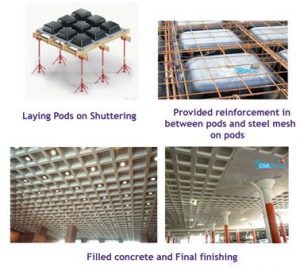
Where to use Waffle Slab & Waffle slab details:
A waffle slab has a holes underneath, giving an appearance of waffles. It is usually used where large spans are required (e.g auditorium, cinema halls) to avoid many columns interfering with space. Hence thick slabs spanning between wide beams (to avoid the beams protruding below for aesthetic reasons) are required. The main purpose of employing this technology is for its strong foundation characteristics of crack and sagging resistance. Waffle slab also holds a greater amount of load compared with conventional concrete slabs.
Types of Waffle slabs:
Based on the shape of Pods (PVC Trays) waffle slabs are classified into the following types:
- Triangular pod system
- Square pod system
Advantages of Waffle slabs:
- Waffle slabs are able to carry heavier loads and span longer distances than flat slabs as these systems are light in weight.
- Waffle slab can be used as both ceiling and floor slab.
- Suitable for spans of 7m – 16m; longer spans may be possible with post-tensioning.
- These systems are light in weight and hence considerable saving is ensured in the framework as the light framework is required
Disadvantages of Waffle slabs:
- Waffle slab is not used in typical construction projects.
- The casting forms or moulds required for precast units are very costly and hence only economical when large scale production of similar units are desired.
- Construction requires strict supervision and skilled labour.
Dome Slab:-
This kind of slab is generally constructed in temples, Mosques, palaces etc. And Dome slab is built on the conventional slab. The thickness of Dome slab is 0.15m. Domes are in the semi-circle in shape and shuttering is done on a conventional slab in a dome shape and concrete is filled in shuttering forming dome shapes. This is one of the types of concrete slabs.
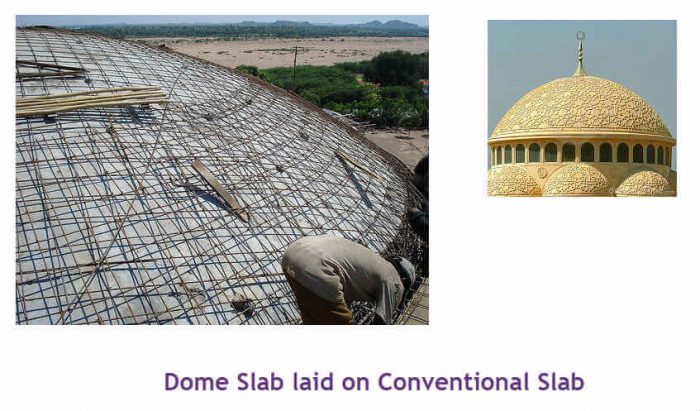
Pitch roof slab:
Pitch roof is an inclined slab, generally constructed on resorts for a natural look. Compared to traditional roofing materials Tile-sheets used in pitch roof slab are extremely lightweight. This weight saving reduces the timber or steel structural requirements resulting in significant cost savings. Tile-sheets are tailor made for each project offering labour cost savings and reduced site wastage. And the thickness of the slab depends on the tiles we using it maybe 2″-8″. This is one of the types of concrete slabs.
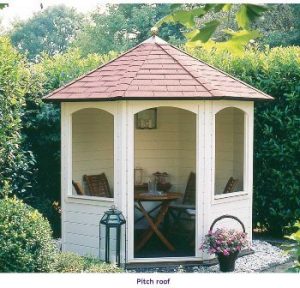
Advantages of Pitched roof type of Slab:
- Pitched roof sheds off rainwater better.
- This slab gives you internal storage or room space.
- It is less likely to leak.
- Roof coverings are cheaper.
- If it is a standard pitch, building materials are more cost-effective
Disadvantages of Pitched roof type of Slab:
- This type of slabs is not suggested for long spans.
- Repairs in slabs like plumbing repair or electric wiring on slabs are difficult.
Slab with Arches:
This is a type of slabs which is generally adopted in the construction of bridges. Bridges are subjected to two loads moving loads from the vehicles and Wind load. Slab with arches or (Arch slab) are adopted at a place where there is a need for redirecting wind load and if there is a long curve in direction of slab these slabs are adopted. It resists the fall of the bridge due to heavy wind load.
They were originally built by stone or brick but in recent times these are built by reinforced concrete or steel. The introduction of these new materials allows arch bridges to be longer with lower spans.

Post tension slab:
The slab which is tensioned after constructing a slab is called Post tension slab. Reinforcement is provided to resist the compression. In Post tension slab the reinforcement is replaced with cables/ steel tendons.
Post-Tensioning provides a means to overcome the natural weakness of concrete in tension and to make better use of its strength in compression. The principle is easily observed when holding together several books by pressing them laterally.
In concrete structures, this is achieved by placing high-tensile steel tendons/cables in the element before casting. When concrete reaches the desired strength the tendons are pulled by special hydraulic jacks and held in tension using specially designed anchorages fixed at each end of the tendon. This provides compression at the edge of the structural member that increases the strength of the concrete for resisting tension stresses. If tendons are appropriately curved to a certain profile, they will exert in addition to compression at the perimeter, a beneficial upward set of forces (load balancing forces) that will counteract applied loads, relieving the structure from a portion of gravity effects. This is one of the types of concrete slabs.
In this type of slab, cables are tied instead of reinforcement. In Steel reinforcement, the spacing between bars is 4inch to 6inch whereas in Post tension slab the spacing is more than 2m.

Advantages of Post tension slab:
- It allows slabs and other structural members to be thinner.
- It allows us to build slabs on expansive or soft soils.
- Cracks that do form are held tightly together.
- Post tension slabs are excellent ways to construct stronger structures at an affordable price.
- It reduces or eliminates shrinkage cracking-therefore no joints, or fewer joints, are needed
- It lets us design longer spans in elevated members, like floors or beams.
Disadvantages of Post tension slab:
- The Post tension slab can be made only by skilful professionals.
- The main problem with using Post tension slab is that if care is not taken while making it, it can lead to future mishaps. Many times, ignorant workers do not fill the gaps of the tendons and wiring. These gaps cause corrosion of the wires which may break untimely, leading to some failures unexpectedly.
Pre Tension Slab :
The slab which is tensioned before placing the slab is called Pre tension slab. The slab has the same features of Post-tensioning slabs.
Cable suspension slab:
If the span of the slab is very long, then we go for cable suspension slab which is supported on cable such as London Bridge, Howrah bridge etc. Generally, in the construction of houses for every 4m, we provide a column whereas in cable suspension slab for every 500m we provide a column. This kind of slab is provided where the length of the span is more and difficulty in building columns. The slabs are tied with cables and these cables are joined to columns.

Low roof slab:
The slab which provided above the door for storage purpose is called Low roof slab. This type of slab is closed at all ends and open at one end. This slab lies below the actual slab and above the door sill level. These types of concrete slabs are used in houses.
Projected slab:
The slab which has one side fixed and the other side is free is called a Projected Slab or Cantilever slab. These type of slabs are generally constructed in hotels, Universities, function halls, etc. to use that area for dropping or picking up zone and for loading and unloading area. This is one of the types of concrete slabs.
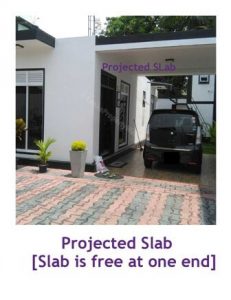
Grads Slab/ Slab on grade:
The slab which is cast on the surface of the earth is called a Ground slab. This type of slab is used on the Basement floor.
There are two types of Grade slabs:
- Usually after casting Plinth beams. Sand is filled at a height of 0.15m and then Sand level is rammed. Then PCC is poured on sand upto a height of Plinth beams. Its an economic way of constructing ground slab which uses majorly in India.
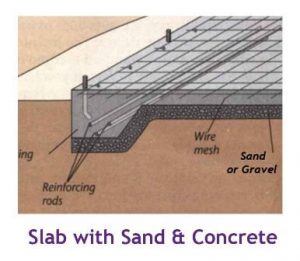
- In high rise buildings after constructing Plinth beam the termite control is done in between the beams and then polythene sheet is laid to avoid termites inside the slab and then steel mesh is provided and concrete is filled. This costs more when compared with the previous one and requires more concrete than the first one.
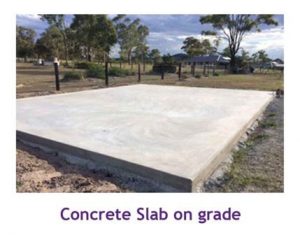
Sunken Slab :
The slab which is provided below the washrooms to hide the sewage pipes or sewerage pipes is called Sunken slab. In this type, the pipes that carry water are concealed below the floor. Special care has to be taken to avoid leakage problems. After casting sewage pipes in the slab the slab is filled with coal or broken pieces of bricks. There are two types of sunken slab.
The slab which is provided below the normal floor level at a depth of 200mm to 300 mm and filled with broken pieces of bricks is called Sunken slab.
or
The Slab which is provided above the normal floor level at a height of 200mm to 300mm and filled with coal or broken pieces of bricks called Sunken slab.
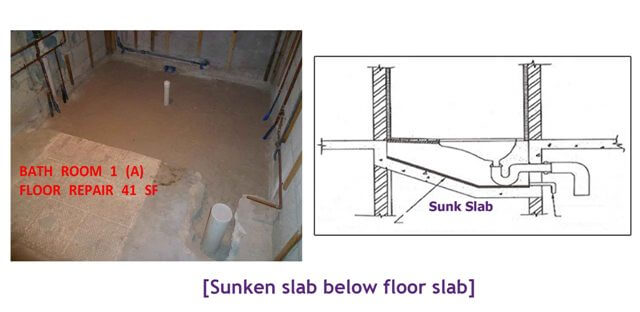
Miscellaneous Slabs:
Room Chajja or Loft :
This kind of chajja (Slab) is provided in drawing rooms and kitchen for storing House material. The usual difference between low roof slab and Room chajja is Low roof slab hides house material and whereas Room Chajja or Loft doesn’t hide house material they are open and provided above the door side. This is one of the types of concrete slabs.

Kitchen Slab :
The slab is provided in the kitchen for its platform. For placing stove and other kitchen, material is called Kitchen Slab. It has a breadth of 0.5m and length of wall and thickness is 2″.
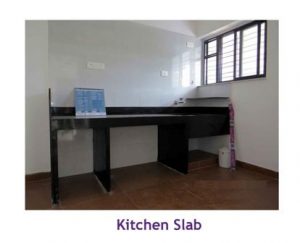 Lintels:
Lintels:
- Lintels are provided Inside building above the doors and windows to re direct the top load. There are two types of lintels.
- Pre cast Lintels: Lintels which are manufactured in factories is called Pre cast Lintels.
- Cast in situ: Lintels are casted at the site itself is called Cast in situ lintels.
The length of the lintel is more than door length and has a width of the wall, thickness of lintel is 0.1m

Sun Shade slab:
- Sun Shade is provided outside building above the doors and windows are called Sun shade slab. The slab stops rain to come inside the building and direct sunlight. This is one of the types of concrete slabs.

Also Read:
For Instant updates Join our Whatsapp Broadcast. Save our Whatsapp contact +9700078271 and Send us a message “JOIN”
Never Miss an update Click on Red notification bell and allow notification. Stay tuned! More are updated Soon!!.
Civil Read Wishes you ALL the BEST

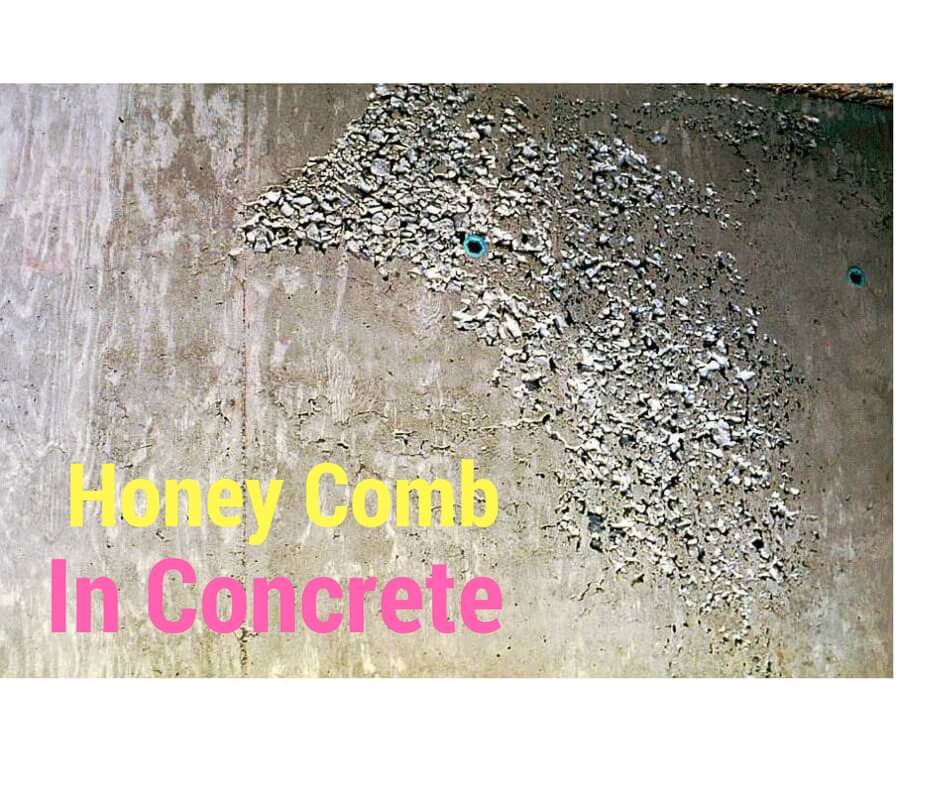
Hi bro .. This blog mostly useful to know everything about construction in easy words and photographs ..
I want suggestion about , if slab height is nearly double the actual slab height ..
Which type of column to be use d.
Size of column and beam you prefer ..
Plz give me suggestions to my mail ..
Thank you
Very helpful article. Thanks for sharing!
In multistoryed buildings having podiums , we lay PCC screed layer of average thickness of around 75 mm , but with minimum thickness of 65 mm on side and on the otherside about 100 mm for slope consideration, followed subsequently by cutting the screed concrete grooves of 10 X 10 mm width on both ways in 2x 2 m sizes. This screed is laid over set RCC slab after applying the bonding agent NITOBOND over RCC slab of the podium. after about one year we see lot of cracks in all directions. how to prevent.
Good
Excellent
Thanks for the resource material.
Hi greetings from tirupathi
Can we build triangle shape slab
Can you suggest at what angle slabe should be build
very good
Very excellent and exciting
helpfull i like it…it has more elaboration on what we need
between concrete and hollow core slab for a one storey house which one is recommended?
depends on the climatic conditions at your region
Great article!
Sir I want construct a house with stone only. Room sizes are required 16′ x 16′ , 16′ x 11′ and 22′ x 11′. Please advise me for further course of action.
Nice sir useful.